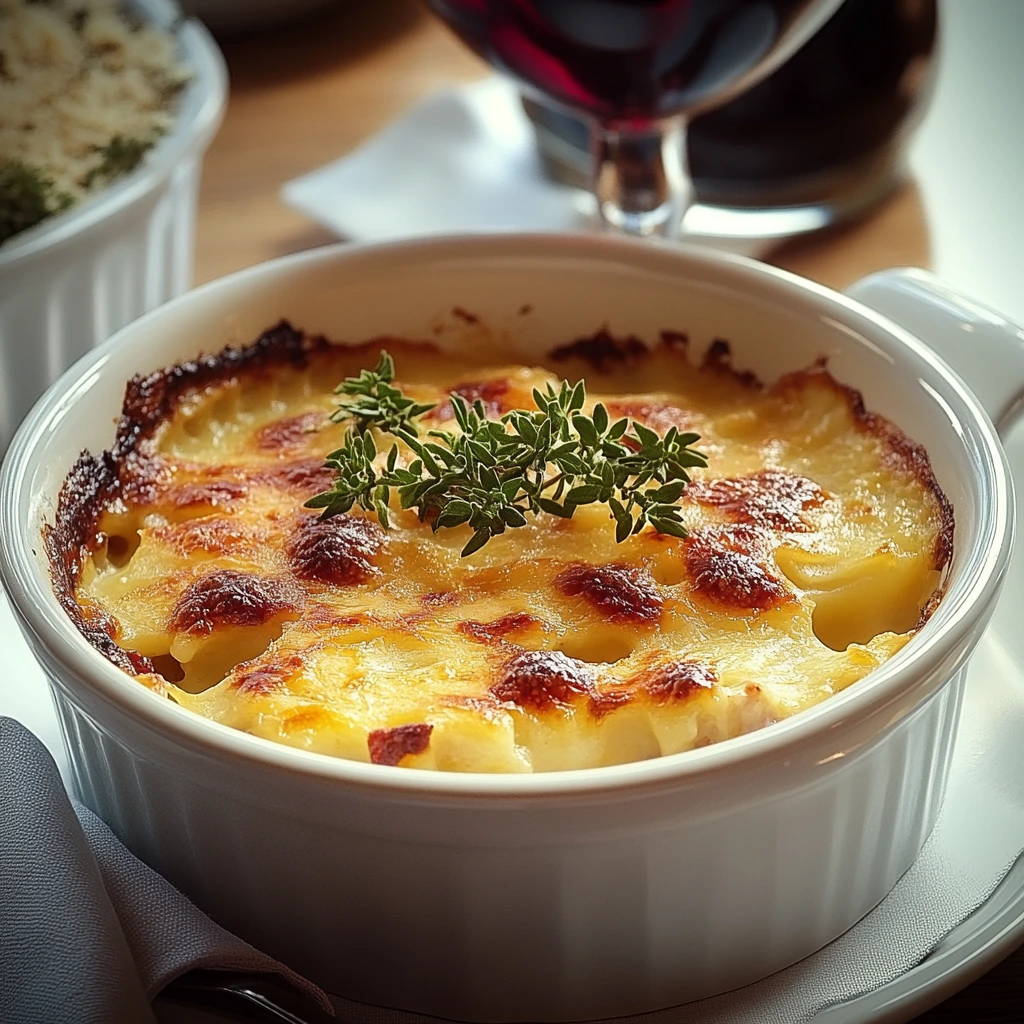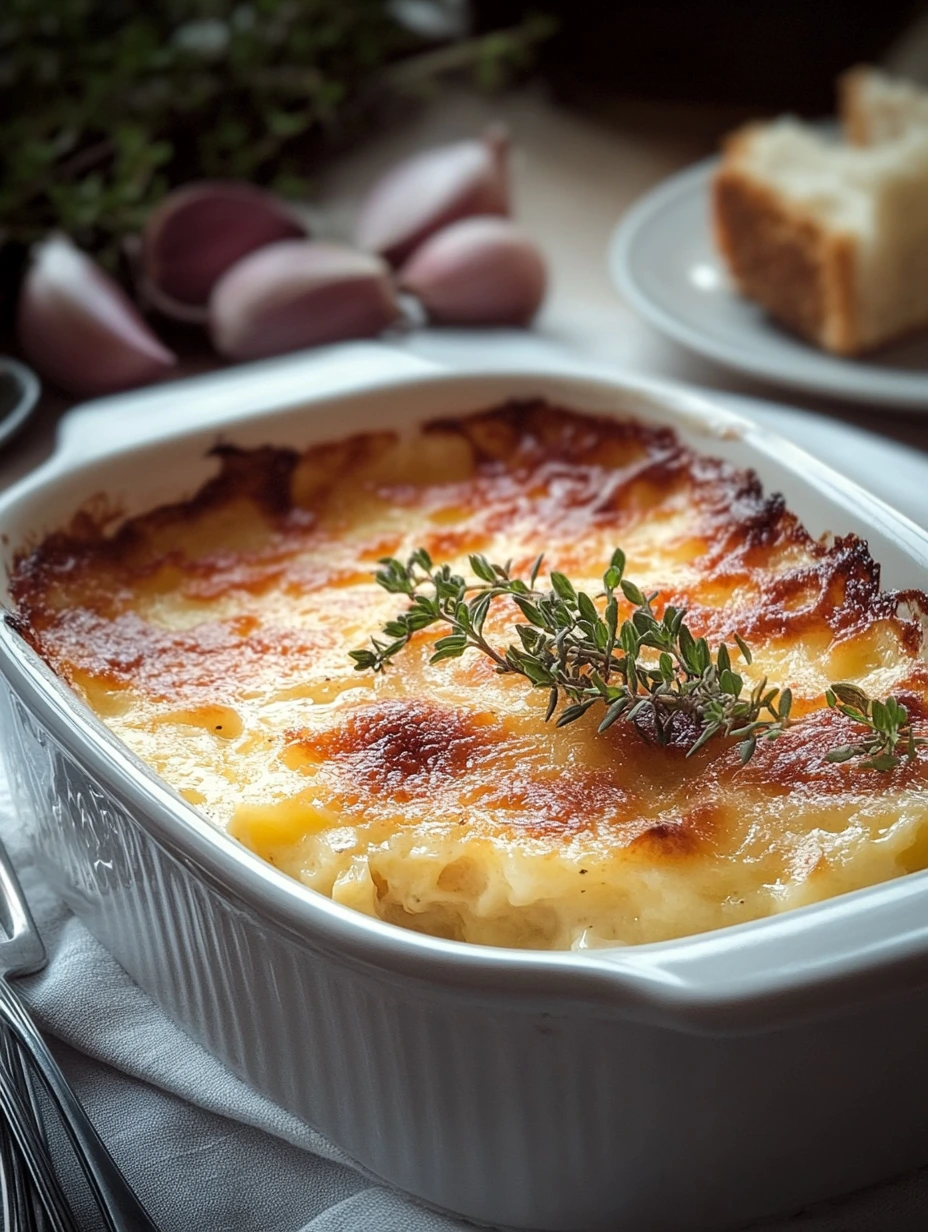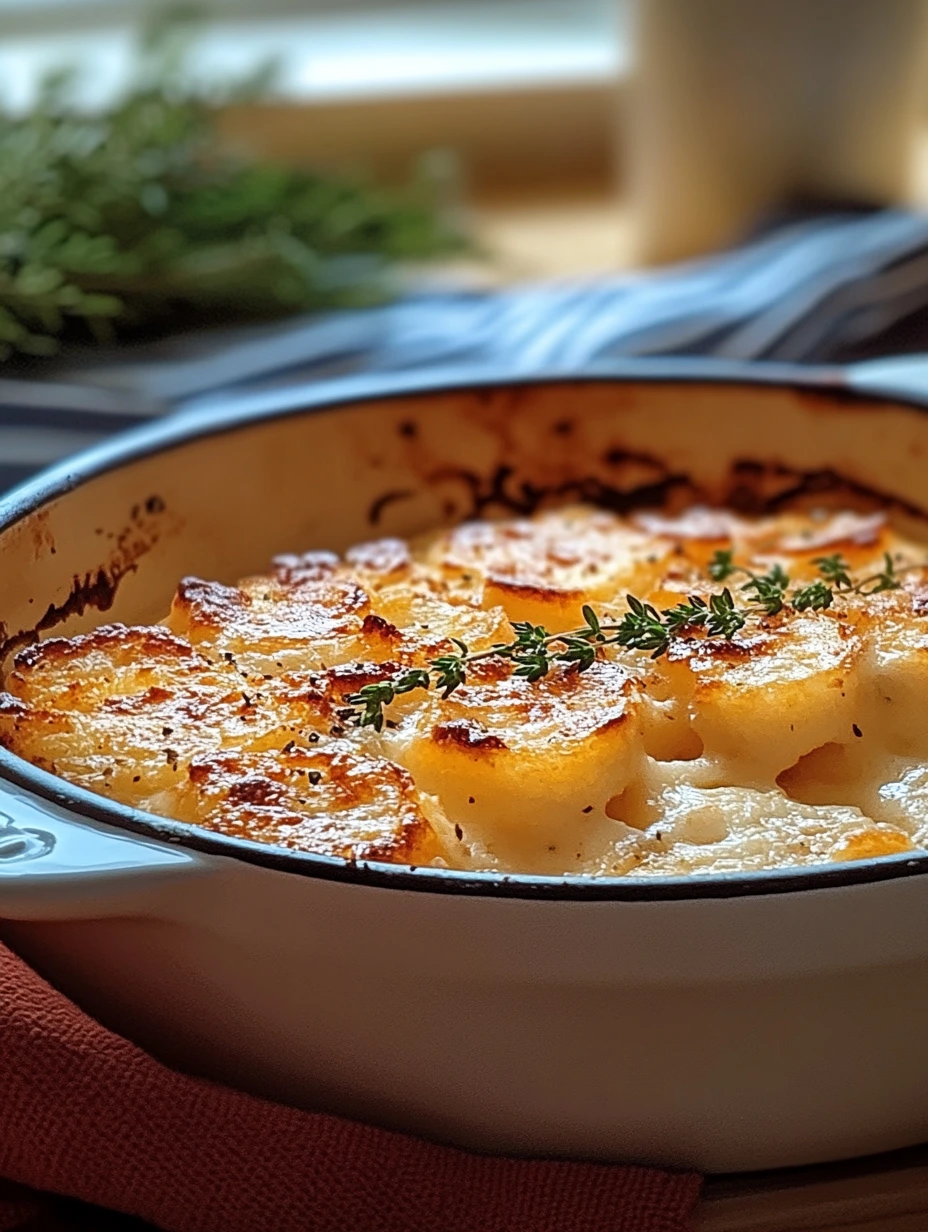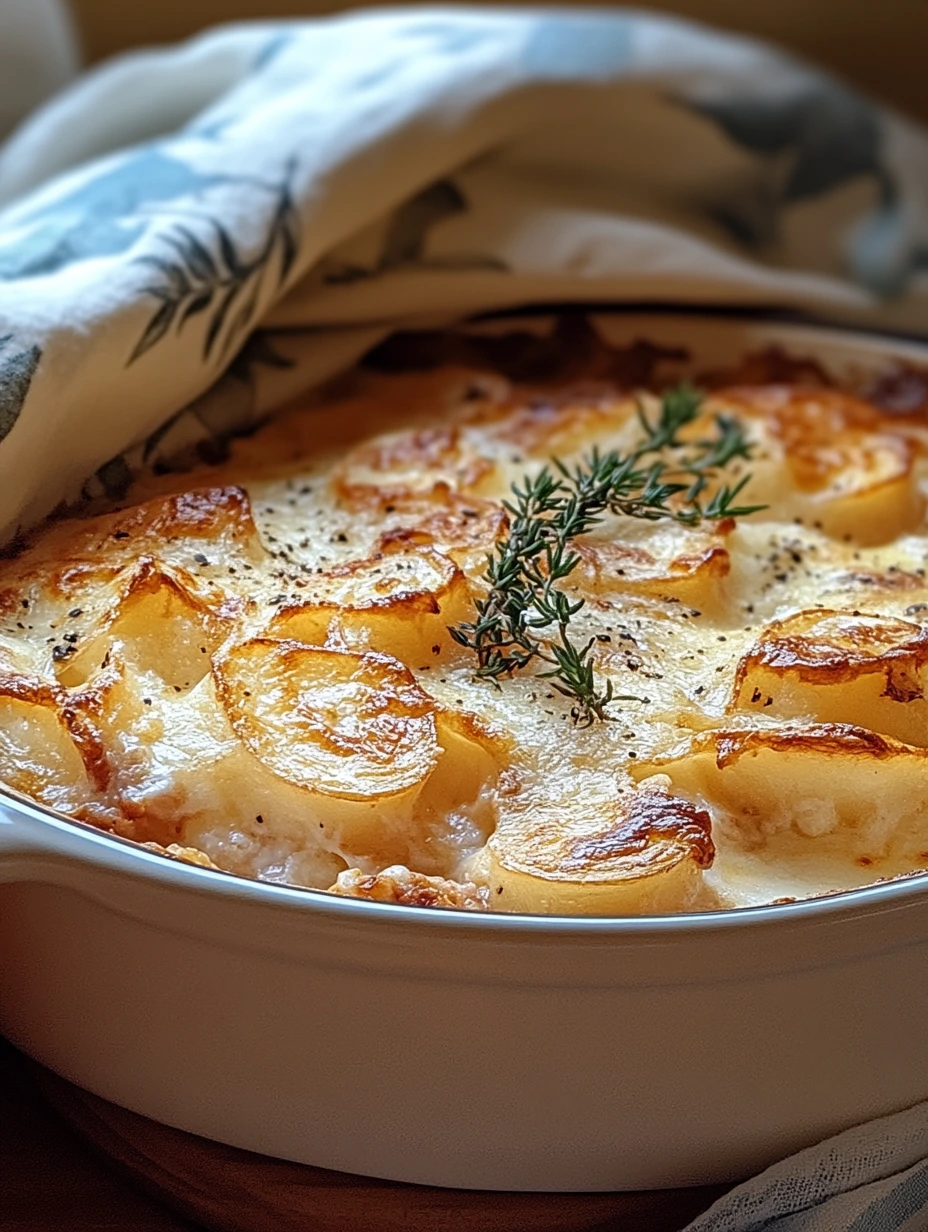 Pin it
Pin it
French potato gratin captures the essence of comfort food at its finest. This seemingly basic dish hides incredible depth of flavor and unmatched creaminess that's made it a timeless classic. Thinly sliced potatoes soaked in a rich, garlicky cream mixture, slowly baked until the top turns golden brown – that's what makes this traditional dish so special. The melt-in-your-mouth texture and richness turn any meal into something special, whether it's a simple weeknight dinner or a fancy celebration.
The first time I made this potato gratin was for an important family dinner. I was nervous at first, but quickly found out it was much easier to make than its elegant results suggest. Everyone at the table savored each bite with pure joy on their faces. My father-in-law, who's super picky about traditional French cooking, even asked me for the recipe - talk about a compliment! Since then, this gratin has become my go-to dish for special occasions, the one everyone always asks for.
Essential Elements
- Potatoes: Go for firm varieties like Charlotte or Bintje that keep their shape while cooking but still soak up all that cream goodness
- Thick cream: This brings the essential richness that makes the dish so famous
- Whole milk: It thins the cream slightly while keeping enough fat for the perfect final texture
- Garlic: Its warm, aromatic notes gently flavor everything without taking over
- Gruyère cheese: With its nutty taste and perfect melting properties, it's the ideal partner for this gratin
- Parmesan: Its stronger, slightly salty flavor adds more complexity to the dish
 Pin it
Pin it
Getting Started
- Getting Started:
- First, heat your oven to 190°C so it reaches the right temperature while you work with the ingredients. Generously butter a rectangular or oval baking dish, ideally ceramic or clay which spreads heat evenly. Carefully peel the potatoes and rinse them under cold water to get rid of extra starch. Using a mandoline set to 3mm thickness or a sharp knife, slice the potatoes into thin, even pieces. This uniformity really matters for even cooking. Immediately put the slices in a large bowl of cold water to keep them from turning gray.
Flavored Cream Mixture
- Flavored Cream Mixture:
- In a heavy-bottomed pot, pour in the thick cream and whole milk. Add finely chopped or crushed garlic that will slowly infuse the mixture with flavor. Season well with fine salt (about a teaspoon) and freshly ground pepper. Some traditionalists add a touch of grated nutmeg for subtle warmth. Gently bring this mixture to a simmer over medium-low heat, stirring often so it doesn't stick to the bottom. As soon as you see the first bubbles, take it off the heat without letting it boil to keep all the delicate flavors intact.
Layering Technique
- Layering Technique:
- Drain the potato slices carefully and pat them dry with a clean towel. Arrange a first layer of slices in the buttered dish, slightly overlapping them like fish scales. Pour a small amount of the cream mixture to cover this first layer, then sprinkle lightly with grated Gruyère. Repeat this process creating several successive layers, ending with a layer of potatoes. Carefully pour the remaining cream mixture, making sure it seeps between all the layers without going over the edge of the dish. The liquid should come almost to the height of the last potato layer without completely covering it.
 Pin it
Pin it
Perfect Baking
- Perfect Baking:
- Generously sprinkle the top with the remaining grated Gruyère and Parmesan to create a golden crust. Cover the dish with aluminum foil, shiny side facing in to reflect heat, and place in the middle of the oven. This first covered phase, about 45 minutes, lets the potatoes cook gently in their creamy bath without burning the top. Then remove the foil and continue baking for another 20 to 30 minutes, until the surface turns beautifully golden and the potatoes are perfectly tender when pierced with a knife tip. Let it rest for 10 minutes before serving so the flavors settle and the texture firms up.
I've got a soft spot for potato gratin because it reminds me of Sunday meals from my childhood. My grandmother had her own version, a bit more rustic, that she made in a big clay dish passed down from her own mother. For her, the secret was patience - she'd let the cream infuse with garlic for nearly an hour before using it. In my family, we've adopted this dish as our traditional side for Sunday roast beef. My husband, who wasn't excited about such a simple dish at first, is now its biggest fan and often takes charge of making it.
Perfect Pairings
This potato gratin goes wonderfully with lots of main dishes, turning every meal into a memorable feast. Serve it alongside a medium-rare roast beef whose juices will mix beautifully with the cream for a complete taste experience. White meats like herb-roasted chicken or guinea fowl with grapes also find a perfect partner in this creamy gratin. For a lighter option, pair it with a simply cooked white fish fillet with lemon butter, creating an appealing contrast between the delicate fish and rich gratin. Vegetarians will especially enjoy this gratin with an arugula salad dressed with balsamic vinaigrette that brings a welcome tangy note against the creaminess of the dish.
Creative Twists
While the classic version is pure delight, a few subtle changes can refresh this traditional dish. For a more rustic take, place thinly sliced onion rings between potato layers, adding extra sweetness to the dish. Food lovers will enjoy adding pre-browned bacon bits that bring a smoky note and contrasting texture. For an herbal interpretation, infuse the cream with fresh thyme and rosemary sprigs that you'll remove before assembly. A more luxurious version involves adding truffle slices between potato layers or a few drops of truffle oil in the cream. For a complete meal, add a middle layer of mushrooms sautéed with garlic and parsley.
Smart Storage
If by some miracle you have leftover potato gratin after the meal, take some care to keep its quality. Let it cool completely before covering with plastic wrap and putting it in the fridge, where it'll keep for up to three days. To reheat, use a conventional oven preheated to 180°C for about 20 minutes, covering with foil for the first 15 minutes to prevent drying out. Then remove the foil to let the top get crispy again. Don't use the microwave as it'll make the potatoes spongy and cause the creamy sauce to separate. If you want to freeze a portion, know that the texture won't be as perfect after thawing, but the taste will still be good.
Success Tips
- Dry the potatoes thoroughly after rinsing so the cream sticks properly
- Your oven temperature matters - a too-hot oven will burn the top before the inside cooks
- Always let the gratin rest a few minutes before serving so flavors can blend together
 Pin it
Pin it
After years of tweaking this recipe, I've found that the real secret to an outstanding potato gratin lies in balance and patience. Balance between the richness of cream and the simplicity of potatoes, between seasoning and the natural flavors of the ingredients. The patience to let each element play its part, to take time infusing the cream, to carefully layer the slices, and to respect the necessary cooking time. This seemingly humble dish shows its true greatness when given the attention it deserves. Every time I serve it, I'm rewarded with an appreciative silence around the table, soon followed by exclamations of pure pleasure - the best compliment any cook could ask for.
Frequently Asked Questions
- → What kind of potatoes work best in this creamy bake?
- Starchy varieties like Yukon Gold or Russet are perfect since they soak up cream well and hold their shape. Firmer types or baby potatoes may stay too crunchy.
- → Can I prep the creamy potato bake ahead of time?
- Absolutely. Assemble it up to the baking step and store it in the fridge for a day. Let it sit at room temp for 30 minutes before baking, and allow a bit more bake time.
- → How do I get a creamy texture without it being watery?
- Dry the potato slices well after rinsing. Use thicker cream, not runny ones, and let the bake sit out of the oven for about 10 minutes after cooking to let everything settle.
- → Is freezing an option for this potato bake?
- Yes, it freezes okay, though texture may change slightly. Freeze after baking in portions, and reheat at 160°C for 20-30 minutes straight from frozen.
- → Can I add spices or herbs for a twist on the original recipe?
- Totally! Try a sprinkle of nutmeg, fresh thyme, or rosemary for extra flavor. Nutmeg especially gives the creamy sauce a cozy boost.
